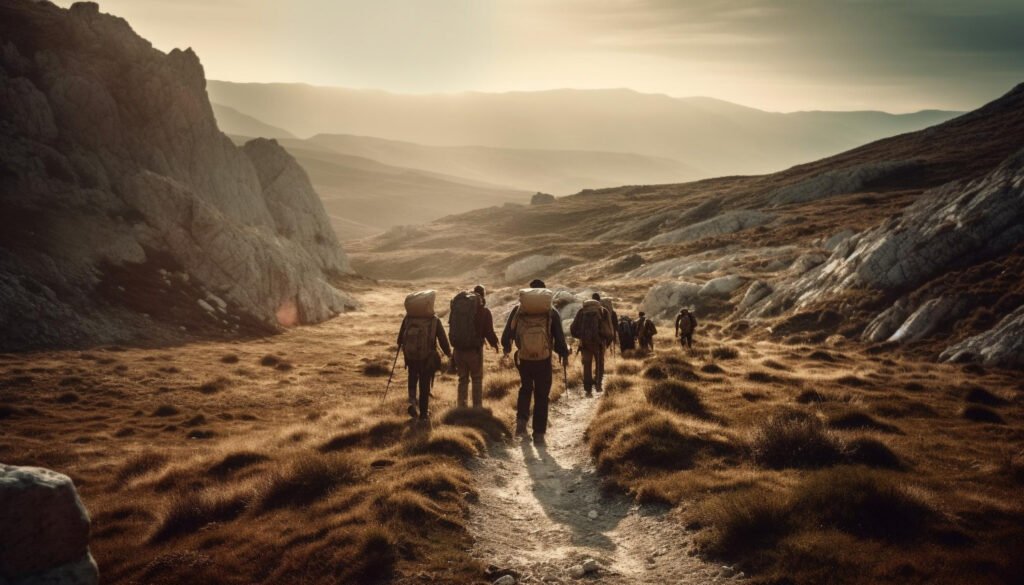The Best Fluffy Pancakes recipe you will fall in love with. Full of tips and tricks to help you make the best pancakes.
Trail Etiquette: Sharing the Trail with Hikers & Riders
Guidelines for respectful and safe trail use.

Mountain bike trails are shared spaces, often enjoyed by hikers, equestrians, runners, and other cyclists. Practicing good trail etiquette keeps riding safe, reduces conflict, and helps protect long-term trail access for the mountain biking community.
From yielding correctly and controlling speed to respecting the environment and building positive community relationships, following these principles ensures that everyone enjoys the outdoors together.
For a full overview of gear, riding skills, and responsible practices, see our Mountain Biking Guide.
Understanding Trail Yielding Rules for Mountain Bikers
Proper yielding creates harmony between different trail users during mountain biking adventures. Cyclists always yield right-of-way to both hikers and equestrians on shared trails. Understanding these fundamental rules prevents conflicts and maintains positive relationships with other outdoors enthusiasts.
Mountain biking riders must yield to hikers because bikes travel faster and more quietly. Horses require special consideration since they can spook easily from sudden bicycle appearances. Uphill mountain biking riders have right-of-way over descending cyclists due to momentum and visibility challenges.
Essential yielding practices:
- Always slow down or stop completely when approaching hikers on trails
- Dismount your mountain bike when passing horses to avoid spooking animals
- Pull aside safely to allow uphill riders to maintain their climbing momentum
- Wait patiently for clear passing opportunities rather than forcing tight squeezes
Practical yielding scenarios:
- Step off trail with your MTB when groups of hikers approach
- Choose wider trail sections for safe passing when possible
- Make eye contact and communicate before attempting to pass other users
Smart yielding demonstrates respect for all trail users and protects mountain biking access rights. Following these MTB trail etiquette rules builds positive community relationships that benefit everyone.
Speed Control and Safe Riding Practices
Responsible speed management keeps mountain biking safe and enjoyable for all trail users. Excessive speed creates dangerous situations and damages trail surfaces through skidding. Controlled riding demonstrates respect for shared outdoor spaces and other trail visitors.
| Trail Situation | Appropriate Speed | Safety Considerations |
| Approaching Hikers | Walking pace | Full stopping capability |
| Blind Corners | Very slow | Unexpected trail users |
| Crowded Trail Sections | Moderate | Quick maneuvering ability |
| Technical Descents | Controlled | Avoid skidding damage |
Ride at speeds allowing instant stops when encountering other trail users unexpectedly. Blind corners require extra caution since hikers or horses may appear suddenly. Skidding destroys trail surfaces and creates erosion problems that affect everyone’s enjoyment.
Speed control best practices:
- Practice emergency braking techniques to improve reaction times during mountain biking
- Choose appropriate gearing for terrain to maintain steady, controlled speeds
- Slow down significantly in high-traffic areas and popular trail intersections
- Avoid sudden acceleration that might startle nearby hikers or wildlife
Trail surface protection:
- Use proper braking technique to prevent wheel lockup and skidding damage
- Choose lines that minimize trail impact during technical mountain biking sections
- Avoid riding on wet trails that damage easily and create lasting erosion
Responsible speed management protects trail access and ensures positive MTB experiences for everyone.
Clear Communication with Other Trail Users
Effective communication prevents accidents and builds positive relationships between mountain bikers and hikers. Friendly verbal warnings give other trail users time to prepare for passing cyclists. Clear communication reduces surprise encounters that can lead to accidents or conflicts.
Verbal communication techniques:
- Use calm, friendly voice tones when approaching hikers from behind
- Announce “mountain biker approaching” or “rider coming through” with adequate warning distance
- Say “passing on your left” clearly before overtaking other trail users
- Thank hikers for stepping aside with genuine appreciation for their courtesy
Alternative communication methods:
- Bicycle bells provide gentle, non-startling alerts for approaching mountain biking riders
- Hand signals work well for communicating with other cyclists on trails
- Eye contact confirms understanding before attempting passing maneuvers during rides
- Slow, predictable movements help hikers judge your intentions and timing
Timing your communication appropriately prevents startling other trail users during mountain biking. Give people adequate time to hear, process, and respond to your presence. Rushing communication creates confusion and potential safety issues on shared trails.
Group riding communication:
- Designate lead rider to handle communication with hikers and other users
- Pass single file to minimize trail disruption and crowding effects
- Space group members appropriately to avoid overwhelming other trail users
- Ensure all group members understand and follow proper MTB trail etiquette
Good communication skills make mountain biking more enjoyable for everyone sharing outdoor spaces.
Respecting Trail Infrastructure and Environment
Environmental stewardship protects trail systems for future mountain biking generations and all users. Staying on designated trails prevents erosion and habitat destruction that threatens access. Proper trail use demonstrates mountain biking community responsibility and environmental awareness.
Trail preservation practices:
- Ride only on designated mountain biking trails and avoid restricted areas
- Stay on established trail surfaces rather than creating shortcuts or alternate routes
- Avoid riding through puddles or muddy sections that widen trails permanently
- Choose walking over riding in environmentally sensitive areas when necessary
Erosion prevention techniques:
- Ride straight through water crossings rather than around edges that widen damage
- Use proper line choices that minimize trail impact during technical sections
- Avoid skidding or wheel spin that creates ruts and erosion channels
- Carry bikes over fragile trail sections when conditions warrant extra protection
Leave No Trace principles for MTB:
- Pack out all trash including energy bar wrappers and water bottles
- Don’t disturb wildlife or remove natural features from trail areas
- Respect private property boundaries and access agreements that allow trail use
- Report trail damage or safety hazards to appropriate land management agencies
Trail maintenance support:
- Participate in volunteer trail building and maintenance days when possible
- Join local mountain biking advocacy groups that support trail development
- Follow seasonal trail closures that protect surfaces during vulnerable periods
Responsible trail use ensures continued mountain biking access and healthy ecosystems for everyone.
Building Positive Community Relationships
Courteous behavior creates lasting goodwill between mountain bikers and other trail users. Simple gestures like friendly greetings build bridges between different outdoor recreation communities. Positive interactions help maintain and expand mountain biking trail access over time.
| Interaction Type | Best Practice | Community Impact |
| Meeting Hikers | Smile, greet warmly | Builds positive MTB image |
| Passing Groups | Single file, patient | Shows consideration |
| Trail Encounters | Offer assistance | Demonstrates community spirit |
Courteous behavior examples:
- Greet other trail users with genuine smiles and friendly hellos
- Offer assistance to hikers who appear lost or need help
- Share trail information about conditions or interesting sights ahead
- Apologize sincerely if you accidentally startle someone during mountain biking
Group riding considerations:
- Keep mountain biking groups reasonably sized to avoid overwhelming trail capacity
- Allow faster hikers to pass your group when appropriate
- Share trail space fairly rather than monopolizing popular sections
- Model good MTB trail etiquette for newer riders in your group
Community building activities:
- Participate in trail cleanup events alongside hikers and other user groups
- Support local businesses that cater to all types of outdoor recreation
- Advocate for inclusive trail policies that accommodate multiple user types
- Share positive mountain biking stories and experiences with non-riders
Conflict resolution:
- Stay calm and respectful if disagreements arise with other trail users
- Listen to concerns and find mutually acceptable solutions when possible
- Report serious conflicts to trail managers rather than escalating situations
Positive community relationships ensure mountain biking remains welcome on shared trail systems long-term.
Summary
Key MTB trail etiquette rules every rider should follow:
✔ Right-of-way rules – Bikers yield to hikers & horses, uphill riders have priority
✔ Speed control – Ride at a pace that allows safe stops and prevents trail damage
✔ Clear communication – Use voice or bells to alert others and announce passes
✔ Respect the environment – Stay on designated trails, avoid erosion, and follow closures
✔ Positive community behavior – Be courteous, resolve conflicts calmly, and volunteer for trail work





